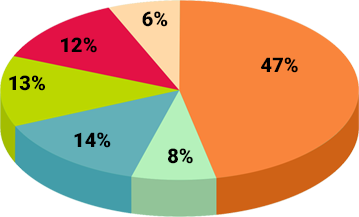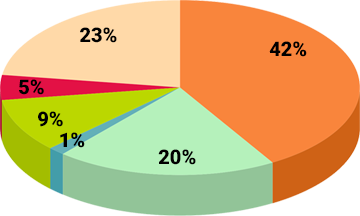The total territory of the Republic of Karakalpakstan is 166.6 thousand square meters. km.
The capital is the city of Nukus (population - 307.6 thousand people).
The structure includes 15 administrative districts and 1 city.
Borders:
- in the west, north, northeast with Kazakhstan.
- in the south and south-west with Turkmenistan.
Population: more than 1.8 million people, more than 60 nationalities.








As of January 1, 2017, the total population of the Republic of Karakalpakstan was 1817.3 thousand people. The number of able-bodied population - 1036.2 thousand people (57.1% of the total population of the region), increased by 1.3% compared to the indicators of 2015.
The largest city of the Republic of Karakalpakstan is the capital city of Nukus with a population of 307.4 thousand people. Other major cities are Khodjeyli, Takhiatash, Chimbay, Beruniy, Turtkul and Kungrad.
The number of employed people is 638.6 thousand people (61.6% of the able-bodied population). Of these, 409.5 thousand people are employed in the production sector, 229.1 thousand people in the sphere of non-material production.
The bulk of the employed population is in agriculture (47.0%), education and culture (42.0%), construction (14.0%), industry (13%), trade (12.0%) and health ( 20.0%).
The bulk of the employed population in the production sector

 Agriculture
Agriculture Transport and communications
Transport and communications Building
Building Industry
Industry Trade
Trade Other
OtherThe number of employed in the sphere of intangible production

 Education and culture
Education and culture Health care
Health care Finance and credit
Finance and credit Household and household services
Household and household services Government Offices
Government Offices Other
OtherThe total population is 1,817,300 people.
(as of Jan. 1, 2012)
Number of employed people (thousand people)

able-bodied population
1036.2 thousand people.

 in the production sphere (409.5)
in the production sphere (409.5)
 in the sphere of intangible production (229.1)
in the sphere of intangible production (229.1)

including, the employed population
638.6 thousand people.
The climate in Karakalpakstan is sharply continental with hot and dry summers, and also cold winters with some minor precipitation. The average temperature in January is -5 to -8 C. The minimum temperature in winter is -38 C. The average temperature in June ranges from +26 to +28 C, and in July and August - +50 C. The average level of precipitation is 100 mm per year.
By the end of 2016, 256.3 thousand tons of vegetable crops, 52.5 thousand tons of potatoes, 127.5 thousand tons of melons, 43.7 thousand tons of fruits and berries and about 6 thousand tons of grapes were harvested.
In 2017, 355.9 thousand tons of vegetable crops, 109.0 thousand tons of potatoes, 146.6 thousand tons of melons, 80.5 thousand tons of fruits and berries and 12.8 thousand tons of grapes are expected to be harvested.
Their biological characteristics, cultivation and application
In 2016, the Republic attracted 13.8 million dollars of foreign investment. To date, 79 enterprises with foreign investments are registered in the Republic of Karakalpakstan, most of them are organized at the expense of foreign investments from China, Russia, South Korea, Great Britain and Kazakhstan. The main field of activity of registered enterprises is processing of licorice root, production of light industry products, production of building materials, oil and gas industry and services. Currently, there are 76 enterprises with foreign investments. The foreign trade turnover of enterprises with foreign investments in 2016 amounted to 436.1 million dollars.
(Presidential Decree No. UP-3594 of 11.04.2005)
Terms of granting tax benefits:
rom 300 thousand US dollars to 3 million US dollars - for a period of 3 years
over $ 3 million to $ 10 million for a period of 5 years
over 10 million US dollars for a period of 7 years
The Nukus FEZ was established in accordance with the Decree of the President of the Republic of Uzbekistan of September 4, 2019. № ПП - 5809
The total area is 32.79 hectares.
Distance:
To the airport - 8 km
The nearest railway station is 1 km away.
Before Tashkent - 1120 km

provision of integrated and effective use of the productive and resource potential of the Republic of Karakalpakstan in terms of growing medicinal plant material in special natural conditions for its further processing;
attraction of foreign direct investments and domestic investors for the creation of modern production facilities for the production of pharmaceutical products and medicines with high added value, primarily on the basis of medicinal substances (substances) and medicinal plant raw materials produced on established plantations;
creation of new modern productions and capacities for the processing of medicinal plant raw materials and the production of medicines, medical products, auxiliary and packaging materials;
deepening the processes of localization of production of pharmaceutical products based on local medicinal plant raw materials and materials on the basis of establishing close cooperation ties and developing industrial cooperation between organizations of free economic zones and the republic as a whole;
the creation of research centers for the study of the introduction and cultivation of medicinal plant raw materials with experimental laboratories.